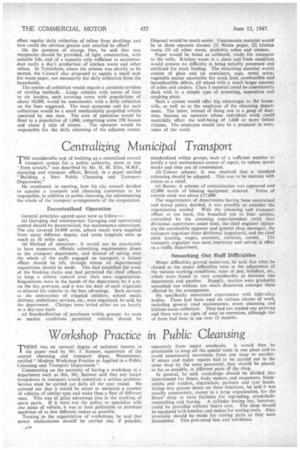New Methods of Refuse Disposal Foreshadowed
Page 43

Page 44

If you've noticed an error in this article please click here to report it so we can fix it.
PAR.
H. GURNEY, cleansing superintendent, Tottenham 1Y4 Borough Council, speaking on "Public Cleansing To-morrow," described how the local authority had been conducting a small-scale experiment to test the opinion of the public as to what it required from post-war cleansing, and to indicate the trend for the future. The investigation showed that the public looked upon all refuse as virtually worthless, desired it to be removed as quickly as possible, was only mildly interested in salvage., and would co-operate fully' in separating kitchen waste from other material provided that the service enabled this to be done with. the minimum of inconvenience.
One of the main purposes of the experiment was to ascertain the proportion of kitchen waste, as compared with other forms of refuse. Two small bins were provided at each of some 50 'dwellings, one to he used for kitchen waste and the other for other types of refuse. These had been emptied daily .for about 18 months, and the contents carefully weighed after each collection.
Among the . interesting facts shown, were that the average yield of kitchen waste was 3.37 cwt. per 1,000 population
per day. The average yield of other refuse was 5.85 cwt. per 1,000 per day, and during the four months, May to August, kitchen waste was about 45 Per cent, of the total weight of all refuse. The proportion of kitchen waste to other refuse decreased rapidly outside the four warmer months, because of the preponderance of ashes and cinders during the colder period. It was also shown that about 80 per cent. of all domestic refuse was the result of preparation of food and the burning of coal. Mentioning two possibilities for the future in the way of improved cleansing, he quoted the use in America of domestic garbage grinders in dwelling houses, which could dispose of vegetable waste by shredding or pulverizing, and he foreshadowed the introduction of atomic energy for power and heating, a process which•could entirely eliminate the ash content in refuse. The partial or general introduction of district heating, he said, might have a similar effect in reducing the, ash content of future refuse.
In the meantime. however, Mr. Gurney wondered what the cleansing services could achieve by less spectacular methods. How, he asked, could they proceed to put into
effect regular daily collection of refuse from dwellings and how could the obvious greater cost entailed be offset?
On the question of storage bins, he said that two receptacles should be provided, of light construction, with suitable lids, and of a capacity only sufficient to accommodate easily a day's production of kitchen waste and other refuse. In Tottenham, where the scheme was shortly to be started, the Council also proposed to supply a small sack for waste paper, not necessarily for daily collection from the households.
The system of collection would require a complete revision of existing methods. Large vehicles with teams of four to six loaders, each covering areas with pOpulations of about 10,000, would be uneconomic with a daily collection on the lines suggested. The most economic unit for such collections would be a small mechanically propelled vehicle operated by one man. The area of operation would be fixed to a population of 1,000, comprising some 250 houses
and about mile of streets. The operator would be responsible for the daily cleansing of the adjacent streets,
Disposal would be much easier. Uneconomic material would be in three separate classes: (I) Waste paper, (2) kitchen waste, (3) all other waste, probably ashes and cinders.
Paper would be baled as collected, ready for transport to the mills. Kitchen waste in a clean and fresh condition would present no difficulty in being suitably processed and sterilized for stock feeding. The remaining material would consist of glass and tin containers, rags, metal scrap: vegetable matter unsuitable for stock feed, combustible and incombustible debris, all mixed with a much larger amount of ashes and cinders. Class 3 material could be conveniently dealt with in a simple type of screening, separation and crushing plant. Siich a system would offer big advantages to the housewife, as well as to the employee of the cleansing department. The latter, instead of being one in a gang of dustmen, became an operator whose individual work could materially affect the well-being of 1,000 or more fellow citizens. The employee would also be a producer in every sense of the word.












































































